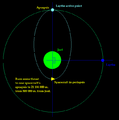Difference between revisions of "Laythe"
m (Change planetbox arguments for atmospheric height.) |
m (→Atmosphere: Improve edge-of-atmosphere number.) |
||
| Line 33: | Line 33: | ||
== Atmosphere == | == Atmosphere == | ||
| − | Laythe's [[atmosphere]] begins at 55, | + | Laythe's [[atmosphere]] begins at 55,262 meters and is slightly less dense than Kerbin's. It is the only natural satellite in the game which has an atmosphere. |
Like all other atmospheres in the game, Laythe's atmosphere fades exponentially with increasing altitude (with a scale height of 4000 m). In general, the atmospheric pressure on Laythe at an altitude expressed in meters is:<ref>A [[LV-N Atomic Rocket Engine|nuclear engine]] has a specific impulse of 220 in 1 atm, 800 in vacuum, and the following at various Laythe altitudes: | Like all other atmospheres in the game, Laythe's atmosphere fades exponentially with increasing altitude (with a scale height of 4000 m). In general, the atmospheric pressure on Laythe at an altitude expressed in meters is:<ref>A [[LV-N Atomic Rocket Engine|nuclear engine]] has a specific impulse of 220 in 1 atm, 800 in vacuum, and the following at various Laythe altitudes: | ||
Revision as of 22:32, 5 February 2013
Laythe is one of the five natural satellites of Jool. Although mostly covered in seas, Laythe has numerous rocky, sandy islands. Laythe is tidally locked to Jool. Synchronus orbits around Laythe are not possible, as they would lie outside of its SOI.
Atmosphere
Laythe's atmosphere begins at 55,262 meters and is slightly less dense than Kerbin's. It is the only natural satellite in the game which has an atmosphere.
Like all other atmospheres in the game, Laythe's atmosphere fades exponentially with increasing altitude (with a scale height of 4000 m). In general, the atmospheric pressure on Laythe at an altitude expressed in meters is:[1]
With proper aerobraking near Laythe and Jool, reaching Laythe may require the least delta-V of all of Jool's moons. When approaching Jool on a Hohmann transfer orbit from Kerbin, aerobraking with a Jool periapsis of 119.5 km will put your apoapsis roughly near Laythe's orbit.
Landing on higher point of Laythe has to be done with a help of retro burns as parachutes alone are not enough to stop the fall.
Jet engines work in Laythe's atmosphere as it contains oxygen. However, their efficiency is slightly lower.
Reference Frames
Rotational/Inertial transition: >600,000 m
| Warp | Minimum Altitude | |
|---|---|---|
| 1x | 0 m | |
| 5x | 30,000 m | |
| 10x | 30,000 m | |
| 50x | 60,000 m | |
| 100x | 120,000 m | |
| 1,000x | 240,000 m | |
| 10,000x | 480,000 m | |
| 100,000x | 600,000 m | |
Gallery
Changes
- Initial Release
Notes
- ↑ A nuclear engine has a specific impulse of 220 in 1 atm, 800 in vacuum, and the following at various Laythe altitudes:
altitude (m) 600 1464 1800 2238 2698 3296 4104 16435 specific impulse 400.7 478.2 504.2 534.8 563.7 596.5 633.7 792.4










